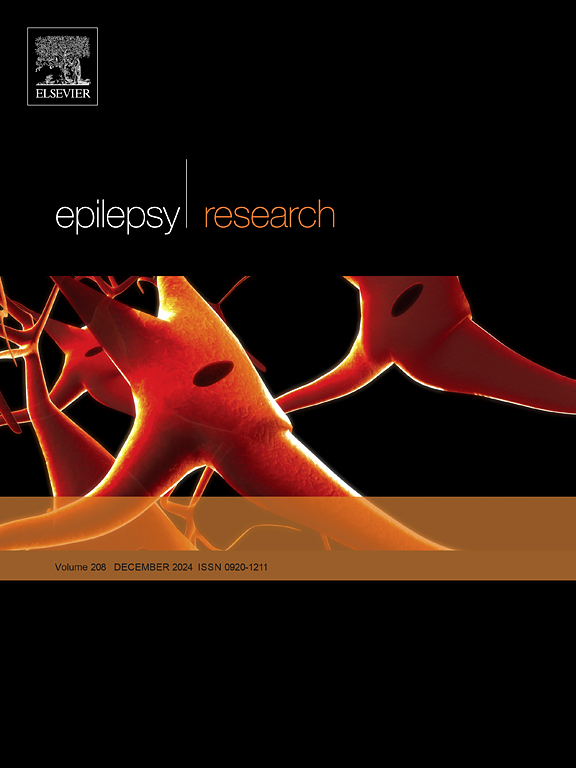Seizure outcome and anti-seizure medication use in post-stroke epilepsy: A retrospective cohort study
IF 2
4区 医学
Q3 CLINICAL NEUROLOGY
引用次数: 0
Abstract
Background
Most patients with post-stroke epilepsy (PSE) are considered to be well controlled with anti-seizure medications (ASMs). First-generation ASMs with potent enzyme-inducing properties can reduce the efficacy of concomitant medications and were related to increased mortality in PSE.
Objective
To evaluate seizure outcome and patterns of ASM use in patients with PSE.
Methods
We retrospectively reviewed the computerized database and the medical records of all the patients who had their first visit in our adult outpatient epilepsy clinic during a 10-year period (2012–2021), and identified 39 patients with PSE and 382 patients with focal epilepsy without a previous stroke (FEWS).
Results
The study group included 421 patients aged 18–90 years, 220 (52.3 %) men, follow-up duration 3.1 ± 2.9 years. At first observation, patients with PSE had lower rates of daily to monthly seizures (p = 0.023) and higher rates of a single seizure (p = 0.023) compared to patients with FEWS, and 66 % were treated with first-generation ASMs. At last observation, seizure frequency improved in fewer patients with PSE compared to FEWS (p = 0.042), with significant decrease in the rate of daily to monthly seizures in patients with FEWS (p = 0.0001).
Conclusions
Seizure outcome in patients with PSE may be less favorable than previously reported, and many were still treated with ASMs that can adversely affect vascular risk. Further studies are needed to evaluate therapeutic strategies that can improve seizure control and achieve higher rates of seizure freedom in patients with PSE.
卒中后癫痫的发作结果和抗发作药物的使用:一项回顾性队列研究
大多数脑卒中后癫痫(PSE)患者被认为通过抗癫痫药物(asm)得到了很好的控制。第一代asm具有强大的酶诱导特性,可降低伴随药物的疗效,并与PSE死亡率增加有关。目的评价癫痫发作的预后及ASM在PSE患者中的应用模式。方法回顾性分析我院成人癫痫门诊10年间(2012-2021年)首次就诊患者的计算机数据库和医疗记录,发现39例PSE患者和382例局灶性癫痫患者无卒中史(FEWS)。结果研究组纳入患者421例,年龄18-90岁,男性220例(52.3 %),随访时间3.1 ± 2.9年。在第一次观察中,与FEWS患者相比,PSE患者的每日至每月癫痫发作率较低(p = 0.023),单次癫痫发作率较高(p = 0.023),66% %的患者接受了第一代ASMs治疗。最后观察,与FEWS相比,PSE患者的癫痫发作频率改善较少(p = 0.042),FEWS患者的每日至每月癫痫发作率显著降低(p = 0.0001)。结论:PSE患者的癫痫发作结果可能不如先前报道的那样有利,许多患者仍接受可对血管风险产生不利影响的asm治疗。需要进一步的研究来评估治疗策略,以改善PSE患者的癫痫控制并实现更高的癫痫发作自由率。
本文章由计算机程序翻译,如有差异,请以英文原文为准。
求助全文
约1分钟内获得全文
求助全文
来源期刊

Epilepsy Research
医学-临床神经学
CiteScore
0.10
自引率
4.50%
发文量
143
审稿时长
62 days
期刊介绍:
Epilepsy Research provides for publication of high quality articles in both basic and clinical epilepsy research, with a special emphasis on translational research that ultimately relates to epilepsy as a human condition. The journal is intended to provide a forum for reporting the best and most rigorous epilepsy research from all disciplines ranging from biophysics and molecular biology to epidemiological and psychosocial research. As such the journal will publish original papers relevant to epilepsy from any scientific discipline and also studies of a multidisciplinary nature. Clinical and experimental research papers adopting fresh conceptual approaches to the study of epilepsy and its treatment are encouraged. The overriding criteria for publication are novelty, significant clinical or experimental relevance, and interest to a multidisciplinary audience in the broad arena of epilepsy. Review articles focused on any topic of epilepsy research will also be considered, but only if they present an exceptionally clear synthesis of current knowledge and future directions of a research area, based on a critical assessment of the available data or on hypotheses that are likely to stimulate more critical thinking and further advances in an area of epilepsy research.
 求助内容:
求助内容: 应助结果提醒方式:
应助结果提醒方式:


